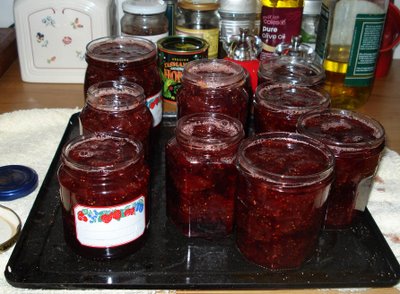I had an email from seagreen last week asking:
I am getting more and more interested in preserving. I've always done a bit, jams and such, as well as drying tomatoes and apples, but this year, thanks to your blog and the forum, I've been making salsa and pickles, using just vinegar, sugar and/or salt to preserve.
I don't have a water bath kit but read on the forum today that the water bath is the only way to preserve vegetables. I hope to do much more preserving of vegetables this year so I wonder if you could either advise me, or perhaps write on your blog, if it's necessary to preserve vegetables that way.
A water bath is one of many ways to preserve food. You can use salt, sugar or vinegar to preserve food and you can dry it. Most bacteria need moisture to survive, if you remove it, by drying the food, bacteria can't grow. Traditionally meat and fish have been dried to keep it going over long winters when people were unable to hunt due to the weather. There are instructions here on how to dry meat, fish and chicken, and here. You can pressure can meat and fish but you can't water bath it.
You can also smoke meat, fish and chicken although this is similar to drying, it also adds its own unique flavour. And for those who like to make things, here are instructions on how to make a smoker using a steel barrel.
If you're going to do a lot of preserving, it's wise to find a good modern book on the subject. You need to follow specific instructions using the correct processing times or amounts of vinegar and/or sugar for all your jars to be safely stored. In Australia you can use either British or Australian books, if you're in the USA or Canada, use local books - we do it differently here and in the UK. I rarely use my water bath if I'm making jam, relish or chutney and I like the River Cottage Handbook No 2 for recipes.
If you're looking to preserve vegetables, you can pressure can almost anything - that preserves food by sterilising it. If you're using a water bath, which never reaches the high temperatures of a pressure canner, you'll have to use only high acid vegetables, such as tomatoes, or fruits or vegetables with vinegar and/or sugar added. Again, read about doing this before you start; you have to have a good understanding of it before diving in.
You can also add flavour while preserving by making chutneys, relish, jams and sauces. Again each item you make has to have enough sugar or vinegar in it to act as a preservative if you intend to not water bath at the end. You follow a recognised recipe to know how much vinegar or sugar to add. Sugar and vinegar act as a preservative because bacteria cannot grow in that environment. If you make sauces, jams, relish etc, you must make sure they are added to hot, sterile jars with sterile lids, as soon as they've finished boiling on the stove. This gives the sauce, jam etc, a bacteria-free environment, and the sugar and vinegar added to the recipe, along with the boiling, will help preserve it.
Wine is one way to preserve a summer harvest of grapes and you can preserve lemons, oranges, passionfruit, pineapple juice as cordials that will keep because of the added sugar content. There is also the age old and various techniques of fermenting a huge range of foods. Sauerkraut and kimchee are the German and Korean traditional ways of preserving cabbage. See here for instructions on how to make them. If you're looking for good books on fermenting, I like Wild Fermentation and Nourishing Traditions. Here is the Wild Fermentation recipe for sauerkraut.
Fruit and vegetables can both be dried for preserving using a dehydrator, slow oven or microwave, or out in the sun under wire gauze to keep the insects off. Click here for an article on how to dry vegetables without a dehydrator.
Fruit and vegetables can both be dried for preserving using a dehydrator, slow oven or microwave, or out in the sun under wire gauze to keep the insects off. Click here for an article on how to dry vegetables without a dehydrator.
I wrote this post a while back about processing food in a water bath using equipment you've probably already got in your kitchen. If you want to try this method of food storage, it may be a good idea to test your skills and methods this way first and if you choose to, you can buy a water bath unit later on.
How do you go about storing small amounts of food or preserving vegetables without a water bath?



